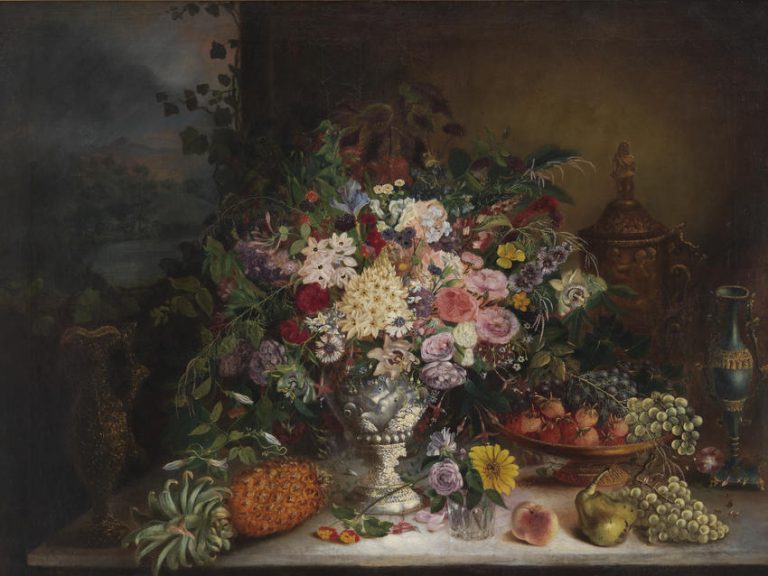We acknowledge the Traditional Owners of the land on which the Queensland Art Gallery | Gallery of Modern Art stands and recognise the creative contribution First Australians make to the art and culture of this country.

Henry Short / England/Australia 1807–65 / Fruit and flowers 1859 / Oil on canvas / 89 x 119cm / Purchased 1997. Queensland Art Gallery Foundation Grant / Collection: Queensland Art Gallery | Gallery of Modern Art
Henry ShortFruit and flowers 1859
Not Currently on Display
This work is a lavish allegorical painting overflowing with succulent fruit and flowers. Masses of flowers spill over the edge of an ornate vase onto a marble surface that also contains fruit arrangements. Henry Short painted still life in the Dutch manner, which used realistic representations of highly prized flowers and fruits, many of them traditional Christian symbols, to create an allegory of the tension between abundance and mortality.
Henry Short was born in London in 1807. In 1852 he arrived in Melbourne with his wife and family during the great wave of migration associated with the discovery of gold in the 1850s. He began exhibiting in 1854, and throughout the 1850s he achieved a substantial reputation in Victoria primarily as a painter of still life in the grand manner.
There was no public gallery in Melbourne at this time, but like other artists, Short consistently exhibited in Fine Art Society shows, in studio exhibitions and through art unions. The still life was his preferred subject matter.
Short’s reputation in this genre was assisted by his emphasis on the bountiful nature of life in Australia where flowers and fruits (even English varieties) grew all year round.
Discussion Questions
1. What can you see in the painting? How does the artist capture your attention?
2. Still life concepts were explored by the Dutch masters of the seventeenth century. Research this era and the symbolism of the imagery used.
Discussion Questions
1. Make a colourful arrangement of fruit, vegetables and/or flowers. Look closely at the objects, draw the arrangement focusing on line, colour, shape, light and shadow. For the background, think about how you can use shading to make sure everyone viewing your still life sees the fruit or vegetables first.
2. Using any media, create an artwork that explores the concept of food as a symbol. Consider how you could represent opposing ideas in one artwork, for example: bitter/sweet, healthy/unhealthy, good/evil, fresh/rotten, young/old. Experiment with the way other objects, like old china or glassware, can help convey your meaning. Your artwork could comment on specific concepts, such as consumerism, gluttony or waste.